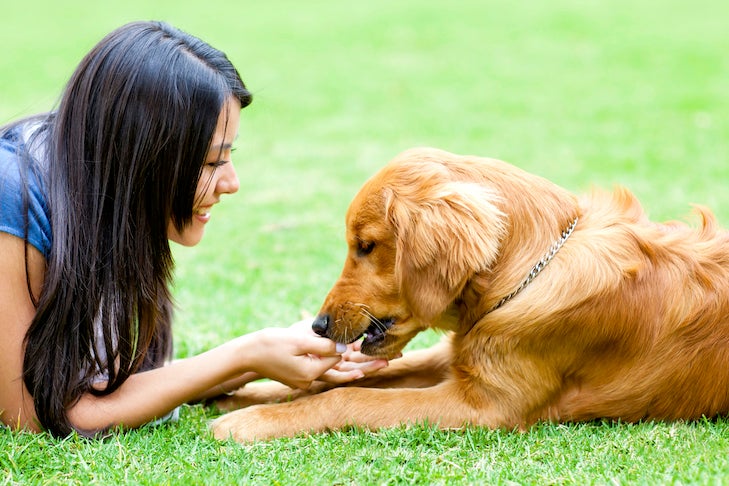AKC is a participant in affiliate advertising programs designed to provide a means for sites to earn advertising fees by advertising and linking to akc.org. If you purchase a product through this article, we may receive a portion of the sale.
A common question you might ask when you start training your dogs is: When can I stop giving them treats? Some owners are in a hurry to put the treats away because they see it as proof that their dog really knows how to do something. In reality, you don’t need to ever completely phase out treats and rewards.
Why We Treat
It’s important to keep reinforcing your dog for a job well done, whether it’s at puppy kindergarten or when working on advanced competition skills. By pairing rewards like treats and toys/play with learning, you’ll be able to help your dog understand new skills faster while also building their enjoyment and enthusiasm for training in general. As your dog becomes more experienced, you can begin to shift how frequently you treat or reward them, but it always should be part of training. Just like you don’t go to work for free, your dog doesn’t want to work for free either. It’s important to make training fun and enjoyable regardless of whether we’re working on basic obedience skills around the house or training a sport.
Luring vs. Rewarding
There’s a difference between using treats as a reward and using them for luring. Luring, which is a useful training method for teaching some new skills, refers to using the treat in front of your dog’s nose to get them to follow it to perform a specific behavior. For example, when teaching a puppy to sit on cue, you can put the treat on their nose and then, while they’re still sniffing at the treat, raise your hand so their nose goes up and their bottom naturally goes down into the sit position. With luring, your dog is following a treat into position and then getting the treat. When training, it’s generally best to phase out luring early and use a smaller visual cue instead. Rewarding is different because instead of following the treat, your dog is getting “paid” with a reward.

Not a Bribe
One reason why many people are in such a hurry to stop treating their dogs while training is the idea that using food/treats as part of training is just a bribe. Really, rewards are just a way to communicate with your dog. There will be moments when you’ll ask your dog to do a cue and you won’t have a treat on you. But because you have built up a strong reinforcement history, they know that the reward is coming, and will perform the cue. By consistently pairing verbal praise with rewards like treats, we build our dog’s understanding and enjoyment of the training process and sports/activities, even when we don’t have a treat in hand and the reward is delayed.
Rate of Reinforcement
Ultimately, the frequency of treating dogs is a personal decision. But as your dog becomes more experienced with a specific skill or activity, you can start to randomize and vary the rate of reinforcement.
If you’re walking your dog, eventually you might choose to give them a lot of verbal praise but only pull out treats to mark/reward their good behavior in more challenging moments such as if you’re walking past a dog that is barking at your dog. When you first start taking your dog on walks, you’ll be consistently treating a lot for skills like loose-leash walking, ignoring things on the sidewalk, passing dogs and people, etc. When phasing out treats, you’ll want to work at your dog’s pace. Remember that needing or wanting to use more treats than someone else doesn’t mean your dog is less trained.
Diversify Your Rewards
Don’t just vary the rate of reinforcement—also diversify the kinds of rewards you offer your dog. Experiment with what is most rewarding to them in terms of treats, food, toys, and games. Dogs have individual preferences, so what is highly rewarding for one dog might be less rewarding for another. Keep a range of treats and rewards with you for different situations.
For example, when practicing tricks your dog knows while you’re in your living room, their regular kibble might be a great reward. But if you’ve taken your dog to a busy outdoor market to walk and train, you may want something they find more high value like string cheese, hot dogs, or soft and smelly treats. For toy-motivated dogs, you can incorporate toys and games like tug or fetch as a reward when training.

